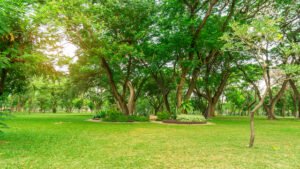
Allow us to talk about cabling and wiring to help support tree limbs and how to support drooping inner tree limbs.
As trees grow, a few of their branches can become heavy or grow with weak attachment points. Trees such as sugar maples are known for big, heavy branches that will rarely ever break, but other trees like red maples or beeches could break under heavy loads such as snowfall. By easing the load on these limbs with tree limb supports, you can reduce the risk of causing property damage and extend your tree’s overall health. Allow us to talk about cabling and wiring to help support tree limbs and how to support drooping inner tree limbs so you are able to protect your trees and property from potential future damage. Read on to learn more!
Common Structural Tree Defects
To understand how to correctly support heavy limbs on trees, it is essential to get a sense of the common structural defects of trees that may have led to the need for additional support.
- Dying, dead, or diseased branches that result from poor growth, pest activity, or storms. An unbalanced or sparse canopy produces either dead or overly exposed branches
- Thinning and bad canopy health from environmental stressors and pest activity. An unbalanced and sparse canopy produces overly-exposed branches
- Unstable branching patterns with weakly attached branches that can’t be easily removed or reduced through pruning
- Minor cracks and seams through the bark and into the tree’s wood as a result of lightning and splitting from weather-related instances
Cabling
Tree limb support cables help restrict the distance that a branch or codominant stem could move in relation to the rest of your trees. This prevents them from bending to the point where they end up breaking. You could see cables used for supporting overextending branches. When it comes to how to use cables to support tree limbs correctly, arborists will assess and determine how many cables are required or if brace rods have to be used with the cables. They will then be able to determine the right point at which cable will be the most supportive, if you’re getting a lightning protection set up as well, the cable system components will all be connected to this system.
Tree Stakes
A bit different than brace rods and cables, tree stakes hold your newly-planted or moved trees upright and keep the rootball in place until it establishes itself in the surrounding soil. Most of the time, certified arborists discourage staking since trees with correct root systems do not need staking at planting and have to be able to flex in the wind to establish good stem taper and strength. Give Harford Tree a call today!
Tree Care and Maintenance from Harford Tree
Ready to have the beautiful yard you have always dreamed of? Harford Tree Experts & Landscaping, Inc has been in the business for decades, providing customers with quality work and quick responses all at the right price. We service the areas of Harford County, Baltimore County, and Baltimore City areas including Bel Air, Fallston, Perry Hall, Towson, Essex, Parkville, White Marsh and Middle River.
For service during business hours, reach out to us or give us a call at 410-592-7321. We offer 24/7 emergency service as well, just give us a call at 443-250-6649. For updates about our business and more informative tips, follow us on Facebook and Twitter.
